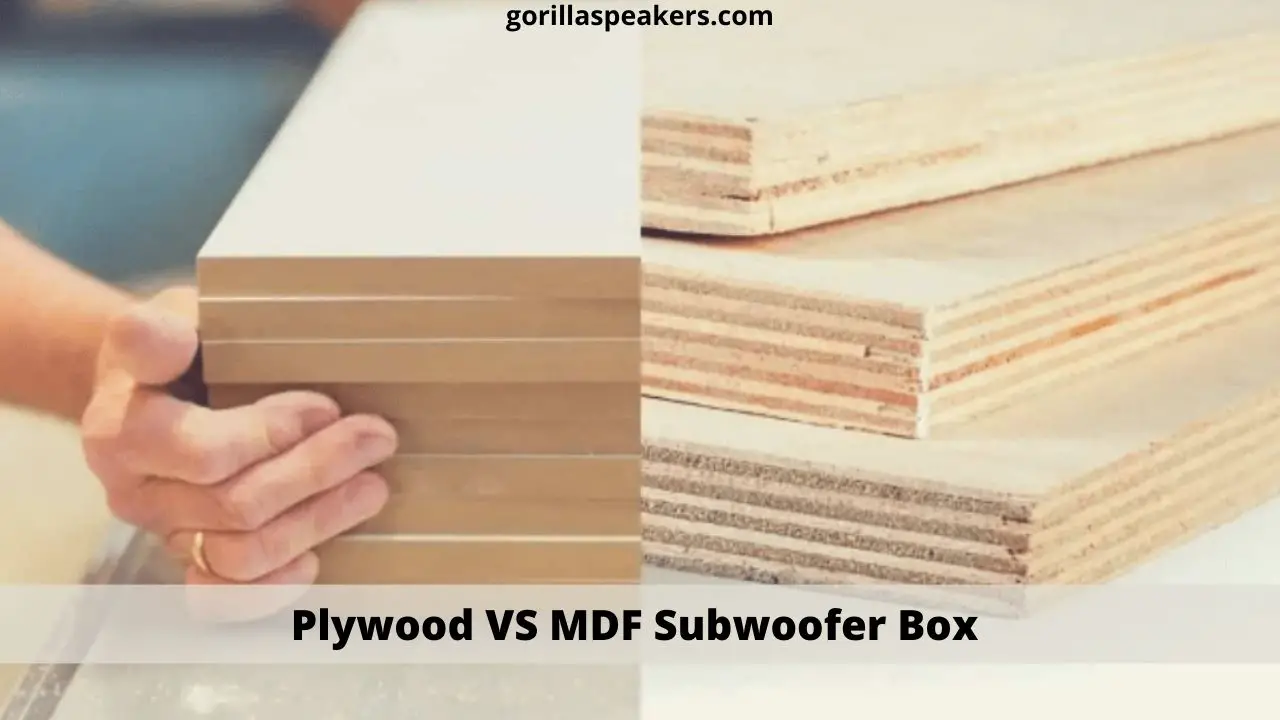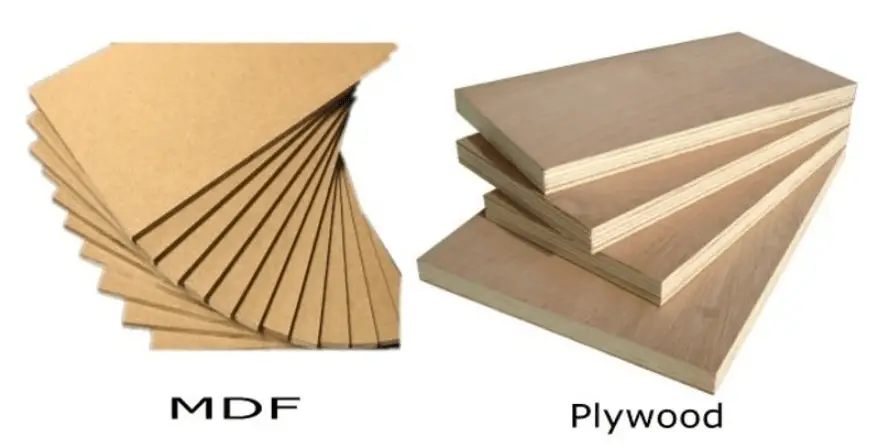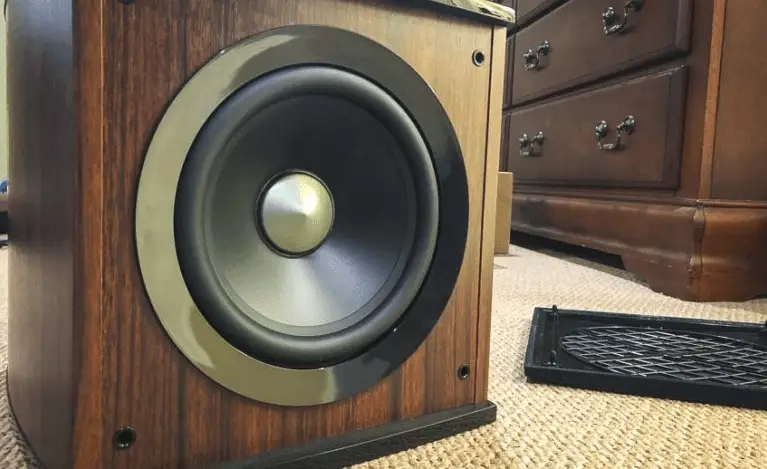Searching for the perfect wood for a subwoofer enclosure is more difficult than finding the best wood for a regular home cabinet because you need to choose a wood form that enables sound to resonate easily.
Acoustically speaking, if you’re planning to purchase or build a subwoofer box, you’re likely stuck between an MDF and a plywood board.
Plywood is a thick, flat wooden sheet that is extremely strong and durable. It is constructed out of several layers of wooden sheets glued together.
On the other hand, MDF is an engineered wood product made of wood residuals pressed into a sheet that is denser than Plywood but much softer.
In this article, we have compared Plywood and MDF subwoofer boxes, as well as their benefits and drawbacks. What makes plywood subwoofer boxes superior to MDF or vice versa? Let us investigate!
Plywood VS MDF Subwoofer Box: Comparison Table
| Aspects | Plywood | MDF |
| Strength and durability | Harder material | Soft material |
| Water resistance | Soaks up water slowly | Soaks up water fast |
| Thickness | Less dense | Denser than plywood |
| Price | Expensive | Relatively cheaper |
For many purposes, MDF is the most popular material for subwoofers. This engineered wood is extremely long-lasting.
It’s dense and thick, which aids in bringing out the best audio experience from your subwoofer, as opposed to a thinner board, which allows sound to resonate and distort. Despite its weight, medium density fiberboard is relatively inexpensive and widely available.
On the other hand, Plywood is preferred due to its hardness and lightweight. As a result, it does not affect the tone of the music coming from the subwoofer. It has excellent sound quality and clearness.
Even though there are many types of Plywood to choose from, which stands out for improving a subwoofer’s performance and sound output
As a result, it creates subwoofer boxes that last a long time. Despite its density, it is light and portable. Resultantly, a sub box made of Plywood can be conveniently moved from one location to another as required.
Plywood VS MDF Subwoofer Box: Strength and durability
Your subwoofer will be moving a lot of air and doing a lot of heavy lifting on the low end. The material of the box will affect the sound and picking the incorrect material can be disastrous.
Having said that, both Plywood and MDF are widely known and strongly recommended, but if you have to choose one, we recommend going with Plywood because it is stronger and significantly lighter than MDF.
Plywood is known for its density and solidity. Acoustically, it provides an amazing output that is only rivaled by a few other wood types.
It is also long-lasting and will outlast your subwoofers. And if you commonly drive on a shaky road, you can rely on Plywood as a subwoofer enclosure to keep your audio system safe.
It’s thick, and the sheets are all the same thickness. As a result, it is less prone to warping and more resistant to environmental parameters such as rain and bright sun.
Plywood VS MDF Subwoofer Box: Cost
Plywood is more costly than MDF, even though the audio performance is superb.
You can expect to pay up to $80 for the wood alone, as you will most likely need two sheets of MDF for your subwoofer box. This is a bit expensive, but it’s well good enough to justify it.
On the other hand, Plywood costs more than MDF because it is a stronger and more sturdy wood. Plywood can cost $200 or more depending on the wood’s quality, strength, and thickness.
Plywood VS MDF Subwoofer Box: Sound Quality
Vibrations are one of the causes of distortions, but you won’t have to worry about them with MDF. Using medium density sheets to build a speaker or medium-density fiberboard to build subwoofer boxes will provide you with natural, undistorted sound.
MDF is thicker and denser than most materials on the market, which aids in the reduction of vibrations and mechanical pressures.
Because MDF is relatively thick, your subs will be safe even on rough roads. As a result, MDF makes a great subwoofer enclosure that will put your mind at ease.
On the other hand, Plywood is the finished product of a flat, wooden sheet that is very tough and rigid and made from several layers of wooden sheets glued together.
Because plywood boards are dense, they are excellent for generating high-quality sound. It keeps the sound waves and vibrations at an ideal level while also preventing extra vibrations, making it the preferred option for people who have built a subwoofer box.
Plywood VS MDF Subwoofer Box: Tone and Resonance
Most users want their subwoofers to produce high-quality sound as clearly as possible without vibrations or distortions.
It’s a vital component in considering sub boxes, especially when you have spent a huge amount on them. You wouldn’t want to mess up the clarity and tone of high-end audio gadgets like that. Plywood is the best material you can use for building your subwoofer box, and it will surely provide the best tone and quality than any other material.
But If Plywood isn’t available and you need to look for another option, then MDF is the next best thing you can get. Popular for its rich density and rigidity, this wood type is also the best wood for a speaker box since it facilitates better clarity and tone.
Plywood VS MDF Subwoofer Box: Warping
Warping is a distortion in wood caused by temperature and humidity that changes the shape of the wood. Natural woods that are not uniform warp. As a result, when building a subwoofer, choose a less likely wood to warp.
The primary problem with using distinctive types of wood instead of MDF is warping. You can stain a lovely natural wood enclosure, and it will look fantastic.
Other kinds of wood require more attention to climate changes, especially if you live somewhere with warm summers and cold winters because larger temperature swings make the enclosure more susceptible to warping. The same is true of humid weather.
MDF isn’t nearly as prone to warping, which is why it’s the right material for subwoofer enclosures and speaker boxes overall.
Plywood is made from thin wood veneer sheets that have been laminated and glued together. If not stored or treated correctly, it can easily warp.
I haven’t had any major issues with warpage when using top-notch Plywood, but still, even the most expensive ply can have a slight bow to it. If you have enough space in your shop, you should store your plywood laying flat.
Plywood VS MDF Subwoofer Box: Aesthetics
If you need something that looks a little nicer, a pine plywood board is a viable substitute for MDF. All you have to do is You’ll want to find a good portion with no knots or other flaws that will affect the sound and end up causing warping even more than it already does.
If aesthetics are important to you and you want to stain it and have it look wonderful, you should only use Plywood.
Plywood VS MDF Subwoofer Box: Easy to work
MDF (medium-density fiberboard ) is like natural wood, except that it has a uniform density from one end to the other. The one downside is that it’s awfully heavy, so if you plan on moving your subwoofer around at all, you may want to consider something lighter like Plywood, but still, as it’ll just be sitting in your trunk, you don’t really have to worry about this.
An MDF board is easy to cut by hand, paint, and add personal touches to the finishing. On the other hand, Plywood can also be easily treated with paints to enhance its resistance.
This makes it suitable for a subwoofer box and prevents the sheets from decaying or rotting away. Additionally, Plywood material is soft and more sound-absorbent compared to MDF.
Plywood VS MDF Subwoofer Box: Thickness
Remember, not just any plywood can make a good box. Your chosen Plywood has to be 3/4 “(1.905 cm) thick at the very least. If you can’t find plywood, then we recommend a non-porous, heavy, 3/4 “(1.905 cm) MDF board.
An MDF board is denser, but the resulting weight of the box is nothing to be concerned about (assuming that you’ll be moving your subwoofer cabinet every now and then).
Plywood VS MDF Subwoofer Box: Resistance
Plywood is a lightweight sheet, resistant to environmental factors due to its dense material, giving you the best bass quality. This also results in more stability, which is essential for audio quality.
But remember that Plywood is not waterproof. Plywood is composed of veneer sheets, and because untreated timber is not waterproof, Plywood also is not.
However, Plywood WBP is available in the market. Plywood WBP stands for Water Boiled Proof and is suitable for humid environments.
On the other hand, MDF has better resistance to humidity and other environmental factors when compared to Plywood.
Whatever way you use it, MDF is moisture-resistant, not water-resistant, nor waterproof, and is still prone to swelling and warping if in direct contact with the elements.
Plywood VS MDF Subwoofer Box: Long-lasting
Plywood is known for its durability, So if you need a speaker box that’s made to last, turning to this option would be great for you, especially if you are always off on long, bumpy roads.
Plywood is soft, long-lasting, and has greater resistance to environmental factors. Due to its uniformity, you will experience less warping in the box of the speaker. And ultimately, it will last longer than other woods.
Also, it is treatable, and you can choose to customize it according to your desire. MDF is also a long-lasting material but not as good as a plywood board.
Plywood VS MDF Subwoofer Box: Which Is Better?
Both Plywood and MDF are wooden-based subwoofer box materials. They are strong, lightweight, and, best of all, pocket-friendly. Now, that brings us to the big question – Plywood or MDF?
Plywood is better than MDF for a subwoofer box. Plywood is lighter and stronger, making it more readily portable and durable than its denser rival, MDF. You can easily work on Plywood without degrading its structural integrity. However, quality plywood boards don’t come cheap.
That’s not all. If you were to work on a plywood board, you’d have a smooth experience using all the cutting, drilling, drawing, and boring tools. MDF doesn’t do that.
Instead, its fragile structure gives in to the weight of the manual tools. Any cutting or drilling is met with some resistance, and you must move slowly to prevent unnecessary waste.
Plywood is the obvious winner on a wide account of practical applications in audio. Its strength-to-weight ratio makes it resistant to bending.
Quality plywood boards typically used in highly-customized and high-end installations are light and strong, and you can shape them into just about anything.
To sum it up, MDF is a good material to use to build a subwoofer box. But in some niche cases, you may want to use another gold standard wood, then Plywood is what you need.
Can You Use Plywood for a Subwoofer Box?
A typical subwoofer box features a wooden material manufactured from recycled wood waste.
You can use Plywood for a subwoofer box. Its acoustic properties include sound insulation and the elimination of vibration. In addition, stiffness, strength, and rigidity also help to improve the sound clarity and tone while keeping distortion at a minimum.
Use Voidless Plywood for a Subwoofer Box
Plywood can either be voided, meaning it has holes, or voidless, meaning it has no holes within its structure.
For building a subwoofer always go for voidless Plywood, such as the baltic birch. Voidless Plywood is often a good quality material you can use to build excellent quality speaker boxes. Also, the more layers your Plywood has, the better!
Use The Highest Grade Plywood Possible
Plywood is a multipurpose engineered wood. It comes in grades A, B, C, and D. Grade A plywood is the highest quality (and most expensive), while D has a lower quality.
Manufacturers have a knack for going for cheaper materials. If you’re building a cabinet yourself, check what plywood grade you’re working with. Go for the higher quality plywood.
What Is the Best Wood for a Subwoofer Box?
MDF (medium-density fiberboard) is like natural wood, except that it has a uniform density from one end to the other.
If you’re looking for something much cheaper and easy to work with, an MDF board would be better. It’s easy to cut by hand, paint, and add personal touches to the finishing.
MDF is the best wood to use for a subwoofer box. Although it won’t match up to a high-quality plywood board, MDF is thicker, denser, and cheaper. Plywood is the best option only if you are ready to spend a lot of money. It’s stronger and more durable, but at the same time, more expensive.
Throughout this article, we’ve pointed out that Plywood is better than MDF in almost every aspect. However, the cost of a good plywood board can hurt your wallet if you’re on a budget.
A common reason most people choose MDF for a subwoofer cabinet is that it’s significantly cheaper and produces a decent sound quality.
MDF density absorbs vibrations and minimizes unwanted noise in the output. You can build a solid subwoofer box with beautiful, personal touch with an MDF board.
Final Thoughts
Wood is a perfect material for subwoofer enclosures, but not all woods share the same acoustic properties. Building a sub-box from the wrong material can be a waste of time and money, not to mention the poor sound quality later in the mix.
We recommend both Plywood and MDF boards for your next DIY subwoofer cabinet.
Plywood is better for subwoofer boxes because it’s way harder, creating stronger and lighter boxes, though it’s also more expensive. MDF makes for a great budget-friendly option while still providing good-quality sound.



